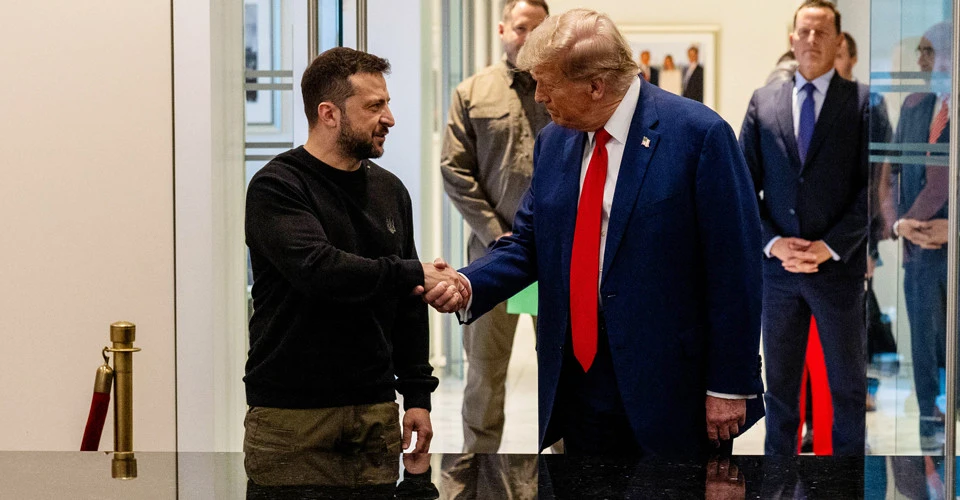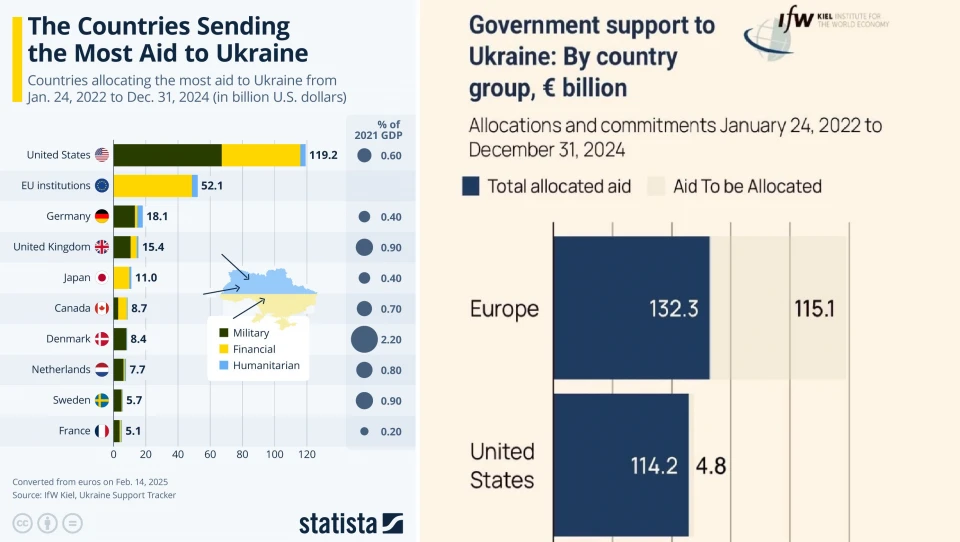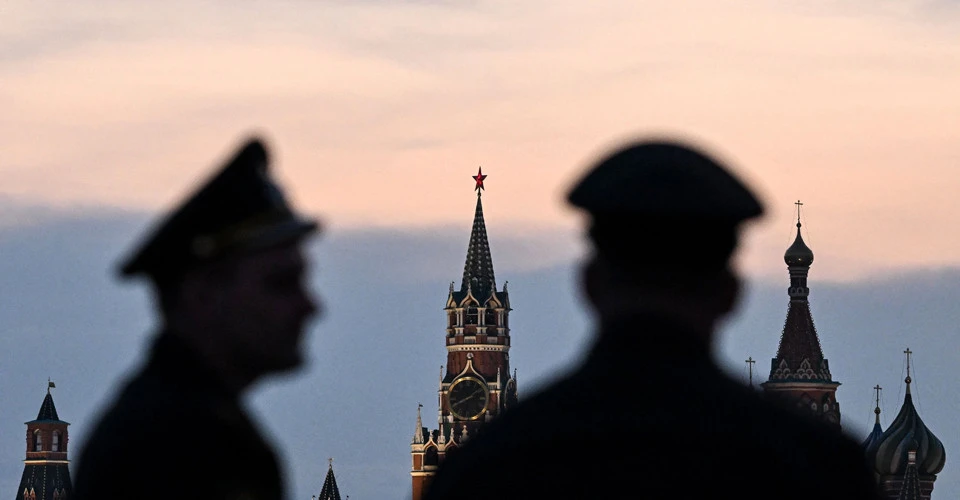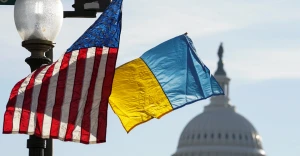
Can Europe’s efforts sustain Ukraine without U.S. support?
Tensions in U.S.-Europe relations—most importantly, between Trump and Zelenskyy—amid Washington’s growing rapprochement with Moscow through direct unilateral negotiations put Ukrainians in an unfamiliar position, where their greatest ally seems just a step away from withdrawing from that role
Espreso explains how much money the U.S. and Europe have allocated to Kyiv, whether we are truly on the verge of major changes, and what this means for Ukraine’s future.
Why is the U.S. changing its policy on Ukraine, and how is money involved?
Since the beginning of Russia’s full-scale invasion of Ukraine in February 2022, the international community has provided significant military, financial, and humanitarian aid to help Ukraine resist the aggressor. Large inflows of support began after the Ukrainian Armed Forces pushed Russian troops out of northern Ukraine, signaling the failure of Putin’s initial plan. The United States took the lead in rallying European allies, ensuring Ukraine received tens of billions of dollars in assistance.
This approach was effective under former President Joe Biden. However, Donald Trump has decided to fundamentally change this policy. Naturally, this shift was welcomed by the Kremlin, which has long repeated its mantra that the war will end once Kyiv stops receiving Western aid. After the resumption of direct U.S.-Russia talks on February 18 in Saudi Arabia, President Trump once again mentioned the figure of $350 billion that Ukraine supposedly owes the U.S. for its support. He also echoed several Kremlin narratives in his own interpretation, particularly about the need for elections, calling Zelenskyy a "dictator without them." In response, President Zelenskyy stated that the war had cost Ukraine $320 billion in total, with the U.S. contributing only about 100 billion.
Even before winning the election, Trump had promised that Ukraine would "pay back American taxpayers' money." To achieve this, he sought to leverage an offer from President Zelenskyy, who had been advocating since last fall in his "Victory Plan" for granting foreign investors access to Ukraine’s natural resources. The Ukrainian government saw this as a mutually beneficial partnership—providing the U.S. with financial gains in exchange for security guarantees. However, in practice, things turned out differently.
The agreement that the U.S. Treasury Secretary brought to Kyiv last week—tellingly, as the first high-ranking official from the new Trump administration to visit Ukraine—would have effectively turned Ukraine into an "economic colony" of America by handing over 50% of its resources, without providing the expected security guarantees, according to The Telegraph and confirmed by Zelenskyy in interviews. This shocked Ukrainian officials, leading Zelenskyy to refuse to sign the deal, instead stating that it needed further revision.
Interestingly, the rare earth minerals that Trump is eager to obtain from Ukraine—and which Zelenskyy had heavily promoted—turned out to be more of a fiction than a reality. Bloomberg reports that Ukraine lacks large deposits of these resources, and even if the country produced 20% of the world's rare earth elements, it would generate only about $3 billion annually. Reaching the hundreds of billions Trump speaks of would take over a century.
Trump’s deal pressure could cost Ukraine its key ally

For businessman-turned-politician Donald Trump, money has always been the top priority. He is used to striking deals that primarily benefit him, and he applies the same approach to foreign policy—pressuring partners into agreements by putting them in uncomfortable positions and using economic leverage to extract concessions. This pattern is evident in his dealings with Canada, Mexico, Greenland, and Panama, where he initially proposed unacceptable terms (such as joining the U.S. as the 51st state), faced rejection, and then imposed economic tariffs to force negotiations.
In Ukraine’s case, Trump isn’t proposing statehood, but rather a deal that would turn the country into a resource supplier on unfavorable terms.
However, what worries Ukrainians and Europeans the most is not Trump's business strategies but his geopolitical vision, which stems directly from them and threatens security across the continent. Since World War II, Europe has relied heavily on the U.S. for defense, making it unprepared to take full responsibility for its own security.
In Trump's worldview, authoritarian regimes are no worse than democracies—perhaps even preferable, as they are easier to negotiate and trade with. He places great value on personal relationships and his own interpretation of history. That’s why, when it comes to Russia, Trump refrains from calling Putin a war criminal and instead seeks to restore his international standing, even discussing Russia’s potential return to the G7 and new joint projects.
This appeasement of Russia—likely to continue in a potential one-on-one meeting before the end of February—comes at Ukraine’s expense, turning the country into a bargaining chip at the negotiating table. If Kyiv is presented with an ultimatum to accept whatever Trump and Putin agree on, will President Zelensky comply? And if Ukraine rejects unfavorable terms, is the country prepared to lose support from its most crucial ally?
At a February 19 briefing, Zelenskyy hinted at this scenario, suggesting that Kyiv and Europe are bracing for a situation where the U.S. issues an ultimatum, receives a refusal, and responds by cutting off aid entirely. This is why European leaders held an emergency summit in Paris on Monday, with a second summit in the works and a potential meeting in the UK soon.
“These are important discussions about what Europe is prepared to do and how it will support Ukraine if U.S. assistance decreases—or if something else happens,” Zelenskyy stated. He previously warned that Ukraine cannot win the war without American support—not just because of funding and weapons but because of U.S. global influence, advanced technology, and strategic dominance.
On the same day, Ukraine’s military intelligence chief, Kyrylo Budanov, told Defence24 that "without the U.S., things will be very difficult for us."
"We must do everything possible to maintain their support for Ukraine. As the saying goes, 'One warrior does not make a battle.' As for Europe, the continent’s security is unimaginable without Ukraine and our heroic army, now the largest in Europe," Budanov stated.
Who has helped Ukraine the most?
 In this context, it is worth examining how much financial support Ukraine has received from the U.S. and Europe. Can European countries step in to replace what has been, metaphorically speaking, Ukraine’s “right hand” if the U.S. cuts off aid?
In this context, it is worth examining how much financial support Ukraine has received from the U.S. and Europe. Can European countries step in to replace what has been, metaphorically speaking, Ukraine’s “right hand” if the U.S. cuts off aid?
According to the Ukraine Support Tracker by the Kiel Institute for the World Economy—a research project that monitors international aid to Ukraine—donor countries have provided Kyiv with a "small but steady stream of support amounting to around €80 billion per year" over the past three years of war.
Since 2022, Europe has emerged as Ukraine’s key donor, particularly in financial and humanitarian aid. However, military spending has gradually increased. Initially, countries supplied Ukraine with weapons from their own stockpiles, but as reserves dwindled, most military aid shifted toward newly manufactured Western arms. Multinational initiatives for weapons procurement have also expanded. Moreover, Donald Trump has suggested that European countries should pay for American weapons before they are sent to Ukraine.
According to the Kiel Institute, over three years, Western nations have allocated approximately €267 billion to Ukraine. This includes:
- €130 billion (49%) for military aid,
- €118 billion (44%) for financial assistance,
- €19 billion (7%) for humanitarian aid.
Despite these significant figures, the support remains modest relative to donor countries' GDP. Germany, the UK, and the U.S. have spent less than 0.2% of their GDP on Ukraine, while France, Italy, and Spain have contributed just 0.1%. For comparison, Germany’s tax subsidies for diesel fuel cost its budget three times more than its military aid to Ukraine. The top three contributors in terms of GDP share are:
1. Estonia (2.2%)
2. Denmark (2.17%)
3. Lithuania (1.8%)
"Europe as a whole has clearly surpassed the U.S. in total aid to Ukraine. In total, Europe has provided €70 billion in financial and humanitarian aid, along with €62 billion in military assistance, while the U.S. has allocated €64 billion for military aid and €50 billion for financial and humanitarian support," the Kiel Institute report states.
The American statistical portal Statista provides more precise figures on Ukraine aid. As of December 31, 2024:
- The United States provided $119.2 billion,
- The European Union — $52.1 billion,
- Germany — $18.1 billion,
- United Kingdom — $15.4 billion,
- Japan — $11 billion,
- Canada — $8.7 billion,
- Denmark — $8.4 billion,
- Netherlands — $7.7 billion,
- Sweden — $5.7 billion,
- France — $5.1 billion.
Analysts note that U.S. support for Ukraine began to decline in the second half of 2023, when Congress blocked new aid packages for nine months. In response, European countries improved coordination and introduced joint procurement mechanisms. The largest initiative, the International Fund for Ukraine (IFU), led by the UK, has accumulated €1.6 billion. Other efforts include the Czech initiative for ammunition supplies and NATO’s Comprehensive Assistance Package.
"The war has become a race in weapons production," says Christoph Trebesch, head of the Ukraine Support Tracker at the Kiel Institute. He emphasizes that for Europe to effectively support Ukraine, it must expand its defense industry through continent-wide cooperation.
Regarding U.S. assistance, an interesting detail emerged: in 2024, Ukraine received only half of the aid promised by the U.S. for that year, as Reuters reported. According to President Zelenskyy, this was one of the main reasons Ukraine lost so much territory last year.
How much is Russia investing in the war?

Although Russia inherited the title of "Europe’s gas station" from the Soviet Union, decades of energy revenues have failed to make it an economic powerhouse. Instead, Russia has poured vast sums into its military and ideological control over society.
If we compare Russia’s nominal GDP (around $2 trillion) with other countries, it ranks between Spain and Italy. However, its GDP per capita is lower than Poland’s, meaning that the real wealth of Russians is highly concentrated in the hands of Putin’s inner circle of officials and oligarchs. This centralized wealth allows the Russian elite to be more effective both in evading thousands of Western sanctions and in adapting the economy for wartime needs through direct state control—an approach that may be efficient in the short term but is generally unsustainable in the long run.
Russia's military spending has skyrocketed since the full-scale invasion of Ukraine. In 2024 alone, Russia increased its defense budget by 42%, reaching 13.1 trillion rubles (approximately $462 billion). According to the Financial Times, this figure exceeds the combined defense budgets of all European nations, which totaled $457 billion that year.
In 2025, Russia's defense spending is expected to rise by another 13.7%, reaching 15.6 trillion rubles—7.5% of the country's GDP and nearly 40% of the federal budget.
According to estimates from the U.S. Department of Defense, from February 2022 to December 2024, Russia spent over $200 billion on equipping, deploying, and maintaining its forces in Ukraine. Reuters sources report an even higher figure—$211 billion. This sum far exceeds the total military support provided to Ukraine by its allies, which amounts to roughly $120 billion (an additional $100 billion has gone toward humanitarian and financial aid).
Mykhailo Podolyak, an adviser to the Ukrainian President’s Office, notes that Russia is spending 30% more on the war than all of Ukraine's allies combined. However, he argues that this spending gap is "only seemingly significant":
"In reality, it can be closed by allocating just 0.2% of Europe’s GDP—that’s $40 billion per year. During the 2008 financial crisis, Europe was spending this amount every month to stabilize its economy. If Europe fails to invest in Ukraine’s victory today, it will have to spend exponentially more tomorrow to arm itself and expand its military forces.
The issue is not the money—these funds exist. The real question is: when will Europe’s survival instinct not only fully awaken but also translate into decisive logistical actions?"
Podolyak leaves this as an open-ended but urgent challenge to European leaders.
Can Europeans replace U.S. aid, and who could be Ukraine’s key ally?
European countries possess enormous financial resources—four of them (Germany, the UK, France, and Italy) rank among the world’s top 10 economies. If the EU were considered a single country, its GDP would be on par with China’s, second only to the U.S. Financially, Europe could replace American aid, but the real challenges lie in weapons production and resource allocation.
For decades, Europe relied on the U.S. as the world’s leading military power and NATO’s backbone. Washington built military bases, expanded missile defense systems, and ensured the security of its allies. However, after the collapse of the USSR, Western nations gradually reduced military spending, shifting funds to economic, social, and cultural programs. This led to the decline of European armies, particularly their ground forces. While Russia’s 2014 invasion of Ukraine served as a wake-up call, it took the full-scale war in 2022 for Europe to take real action. Now, however, fears of another Russian attack on a European country and concerns over Donald Trump’s foreign policy are pushing European leaders toward a more independent defense strategy.
At the heart of Europe’s emerging security system is Ukraine, which serves as a frontline defense against Russian aggression. Supporting Kyiv is therefore an investment in Europe’s own security.
Europe's military production limitations
Unlike the U.S., Europe lacks large-scale military production capacity. Even if European nations doubled their military aid to Ukraine, they would struggle to deliver sufficient weapons because their stockpiles—except for those of the U.S.—are nearly depleted. Ukraine is now receiving newly manufactured weapons rather than surplus stock.
Since Europe’s arms industry is only now ramping up production, it will take years before new factories reach full capacity. That’s why replacing U.S. military aid is so difficult—there simply aren’t enough weapons available for the largest war in Europe since World War II.
Given the risk of a complete halt in U.S. support, Ukraine is seeking European funding to purchase American weapons. The EU is already discussing an additional $5 billion in military aid, including artillery shells, air defense systems, long-range precision missiles, and drones.
Key European allies
- United Kingdom: The UK plans to allocate at least £3 billion ($3.8 billion) in military aid this year under a "100-year partnership" agreement. The aid will include air defense systems and interceptor missiles. If a ceasefire is reached, the UK is prepared to send Typhoon fighter jets and military personnel to Ukraine. The UK is also playing a key role in coordinating the Ramstein group, a coalition of military donors, after the U.S. scaled back its involvement.
- Germany: On February 17, 2025, Germany announced a new military aid package containing hundreds of thousands of shells, air defense missiles, drones, and other weapons. In total, Berlin has pledged approximately €28 billion ($30 billion) in military aid, with €6 billion allocated for the coming years.
- Norway: Oslo plans to spend over $2 billion on military aid, the largest defense commitment in Norwegian history. Additionally, Norway is investing in Ukraine’s defense industry, including joint ammunition production projects.
- Italy: Rome is continuing its military assistance but keeps details classified, unlike other European nations.
- Netherlands, Denmark, Sweden, and others: These countries remain consistent contributors, with ongoing aid packages and arms deliveries.
According to Defense Express CEO Serhiy Zgurets, Ukraine has secured weapons deliveries for at least the next six months. However, he highlights a significant issue: the European military is currently smaller than Ukraine’s army—Europe has around 83 brigades, while Ukraine has 110. This means Europe needs time to rebuild its military strength.
Europe's Path Forward
Zgurets emphasizes that Europe must:
1. Integrate its vast financial resources into a cohesive defense policy.
2. Expand military production—both for Europe and for Ukraine.
This process will take time, but Europe’s role is becoming increasingly central in Ukraine’s war effort, particularly in financial aid, weapons deliveries, and accelerating arms production.
- News











































